
What do the numbers mean? A survey is administered by a marketing firm. Two of the people surveyed are Brenda and Jason. Three of the questions are as follows:
- Do you favor the construction of a new shopping mall?
- How many cars do you own?
- What is your marital slams?
(1) Strongly oppose (2) Somewhat oppose (3) Neutral (4) Somewhat favor (5) Strongly favor
(1) Married (2) Single (3) Divorced (4) Domestically partnered (5) Other
- Are the responses for question (i) nominal or ordinal?
- On question (i), Brenda answers (2) and Jason answers (4). Jason’s answer (4) is greater than Brenda’s answer (2). Does Jason’s answer reflect more of something?
- Jason’s answer to question (i) is twice as large as Brenda’s answer. Does Jason’s answer reflect twice as much of something? Explain.
- Are the responses for question (ii) qualitative or quantitative?
- On question (ii). Brenda answers 2 and Jason answers 1. Does Brenda’s answer reflect more of something? Does Brenda’s answer reflect twice as much of something? Explain.
- Are the responses for question (iii) nominal or ordinal?
- On question (iii). Brenda answers (4) and Jason answers (2). Does Brenda’s answer reflect more of something? Does Brenda’s answer reflect twice as much of something? Explain.
a.
To identify:whether the responses for question (i) nominal or ordinal.
Answer to Problem 49E
The responses for question (i): ordinal.
Explanation of Solution
Given information:A survey is administered by a marketing firm. Two of the people surveyed are Brenda and Jason. Three of the questions are as follows:
Do you favor the construction of a new shopping mall?
(1) Strongly oppose (2) Somewhat oppose (3) Neutral (4) Somewhat favor (5) Strongly favor
ii. How many cars do you own?
iii. What is your marital status?
(1) Married (2) Single (3) Divorced (4) Domestically partnered (5) Other
Concept Involved:
There are various methods of collecting information by sampling. Once the information has been collected, the collection is called a data set. Variables can be divided into two types: qualitative and quantitative. Qualitative variables are also called categorical variable, classify individuals into categories. Quantitative variables are numerical and tell how much of something there is.
Qualitative variables come in two types: ordinal variables and nominal variables.
Ordinal variables are qualitative variables whose categories have a natural ordering.
Nominal variables are qualitative variables whose categories have no natural ordering.
Quantitative variables can be either discrete or continuous.
Discrete variables are those whose possible values can be listed. Often, discrete variables result from counting something, so the possible values of the variable are 0, 1, 2 and so forth.
Continuous variables can, in principle, take on any value within some interval.
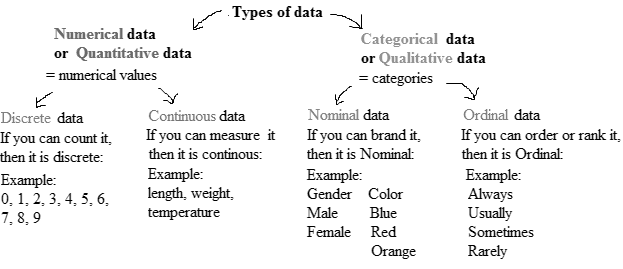
The values are classified into categories in a nominal variable, but no natural ordering is there in categories, whereas, the values are also classified into categories in an ordinary variablebut a natural ordering is there in categories.
Thus, to given question the choices for response has natural ordering with strongly oppose which indicating negative opinion and favor stating intensely positive feedback is ordinal variable.
Therefore, responses to given question are ordinal.
b.
To identify:Whether Jason’s answer reflects more of something.
Answer to Problem 49E
Jason’s answer reflects that he is favor of constructing a new shopping mall unlike Brenda
Explanation of Solution
Given information: A survey is administered by a marketing firm. Two of the people surveyed are Brenda and Jason. Three of the questions are as follows:
i. Do you favor the construction of a new shopping mall?
(1) Strongly oppose (2) Somewhat oppose (3) Neutral (4) Somewhat favor (5) Strongly favor
ii. How many cars do you own?
iii. What is your marital status?
(1) Married (2) Single (3) Divorced (4) Domestically partnered (5) Other
On question (i), Brenda answers (2) and Jason answers (4). Jason’s answer (4) is greater than Brenda’s answer (2).
Concept Involved:
There are various methods of collecting information by sampling. Once the information has been collected, the collection is called a data set. Variables can be divided into two types: qualitative and quantitative. Qualitative variables are also called categorical variable, classify individuals into categories. Quantitative variables are numerical and tell how much of something there is.
Qualitative variables come in two types: ordinal variables and nominal variables.
Ordinal variables are qualitative variables whose categories have a natural ordering.
Nominal variables are qualitative variables whose categories have no natural ordering.
Quantitative variables can be either discrete or continuous.
Discrete variables are those whose possible values can be listed. Often, discrete variables result from counting something, so the possible values of the variable are 0, 1, 2 and so forth.
Continuous variables can, in principle, take on any value within some interval.

It is given that Brenda answered 2 and Jason answered 4. Thus Jason’s answer reflect more of positivity, as he though not sure of intensity of favoring the construction supported it, unlike Brenda.
c.
To identify:Whether Jason’s answer reflects twice as much of something.
Answer to Problem 49E
The variable response to given question is categorical in nature, so it doesn’t not imply Jason’s answer to given question is twice as much of something
Explanation of Solution
Given information: A survey is administered by a marketing firm. Two of the people surveyed are Brenda and Jason. Three of the questions are as follows:
i. Do you favor the construction of a new shopping mall?
(1) Strongly oppose (2) Somewhat oppose (3) Neutral (4) Somewhat favor (5) Strongly favor
ii. How many cars do you own?
iii. What is your marital status?
(1) Married (2) Single (3) Divorced (4) Domestically partnered (5) Other
Jason’s answer to question (i) is twice as large as Brenda’s answer.
Concept Involved:
There are various methods of collecting information by sampling. Once the information has been collected, the collection is called a data set. Variables can be divided into two types: qualitative and quantitative. Qualitative variables are also called categorical variable, classify individuals into categories. Quantitative variables are numerical and tell how much of something there is.
Qualitative variables come in two types: ordinal variables and nominal variables.
Ordinal variables are qualitative variables whose categories have a natural ordering.
Nominal variables are qualitative variables whose categories have no natural ordering.
Quantitative variables can be either discrete or continuous.
Discrete variables are those whose possible values can be listed. Often, discrete variables result from counting something, so the possible values of the variable are 0, 1, 2 and so forth.
Continuous variables can, in principle, take on any value within some interval.
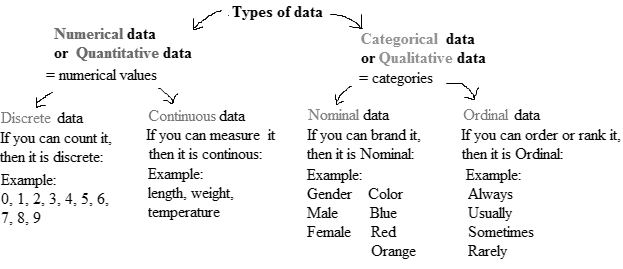
It is given that Brenda answered 2 and Jason answered 4. Thus Jason’s answer reflect more of positivity, as he though not sure of intensity of favoring the construction supported it, unlike Brenda. It is given Jason’s answer to given question is twice as large as Brenda, which does not implies twice as much of something, because, the variable response to given question is categorical in nature.
d.
To identify:Whether question (ii) qualitative or quantitative.
Answer to Problem 49E
The responses for question (ii): quantitative
Explanation of Solution
Given information: A survey is administered by a marketing firm. Two of the people surveyed are Brenda and Jason. Three of the questions are as follows:
i. Do you favor the construction of a new shopping mall?
(1) Strongly oppose (2) Somewhat oppose (3) Neutral (4) Somewhat favor (5) Strongly favor
ii. How many cars do you own?
iii. What is your marital status?
(1) Married (2) Single (3) Divorced (4) Domestically partnered (5) Other
Concept Involved:
There are various methods of collecting information by sampling. Once the information has been collected, the collection is called a data set. Variables can be divided into two types: qualitative and quantitative. Qualitative variables are also called categorical variable, classify individuals into categories. Quantitative variables are numerical and tell how much of something there is.
Qualitative variables come in two types: ordinal variables and nominal variables.
Ordinal variables are qualitative variables whose categories have a natural ordering.
Nominal variables are qualitative variables whose categories have no natural ordering.
Quantitative variables can be either discrete or continuous.
Discrete variables are those whose possible values can be listed. Often, discrete variables result from counting something, so the possible values of the variable are 0, 1, 2 and so forth.
Continuous variables can, in principle, take on any value within some interval.
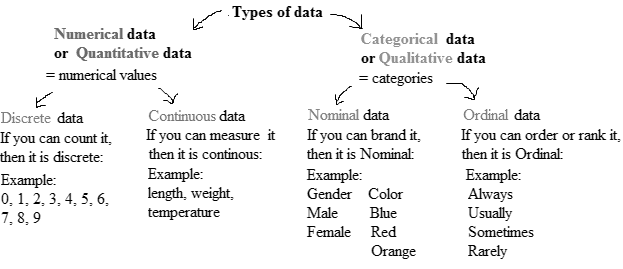
The variable which classifies individuals into categories is called qualitative variable, and the variable whichprovide information aboutquantity or number of something is quantitative variable. The variable number of cars owned by one tells how many cars one had been capable of possessing.
Therefore, the response is quantitative in nature.
e.
To identify:Whether Brenda’s answer reflect more of something and does it reflect Brenda’s answer is twice as much as something.
Answer to Problem 49E
The response is quantitative, Brenda’s answer reflect that she have more cars than Jason.
Yes! Brenda’s answer reflect that she have twice as many cars as what Jason have.
Explanation of Solution
Given information: A survey is administered by a marketing firm. Two of the people surveyed are Brenda and Jason. Three of the questions are as follows:
i. Do you favor the construction of a new shopping mall?
(1) Strongly oppose (2) Somewhat oppose (3) Neutral (4) Somewhat favor (5) Strongly favor
ii. How many cars do you own?
iii. What is your marital status?
(1) Married (2) Single (3) Divorced (4) Domestically partnered (5) Other
On question (ii), Brenda answers 2 and Jason answers 1.
Concept Involved:
There are various methods of collecting information by sampling. Once the information has been collected, the collection is called a data set. Variables can be divided into two types: qualitative and quantitative. Qualitative variables are also called categorical variable, classify individuals into categories. Quantitative variables are numerical and tell how much of something there is.
Qualitative variables come in two types: ordinal variables and nominal variables.
Ordinal variables are qualitative variables whose categories have a natural ordering.
Nominal variables are qualitative variables whose categories have no natural ordering.
Quantitative variables can be either discrete or continuous.
Discrete variables are those whose possible values can be listed. Often, discrete variables result from counting something, so the possible values of the variable are 0, 1, 2 and so forth.
Continuous variables can, in principle, take on any value within some interval.
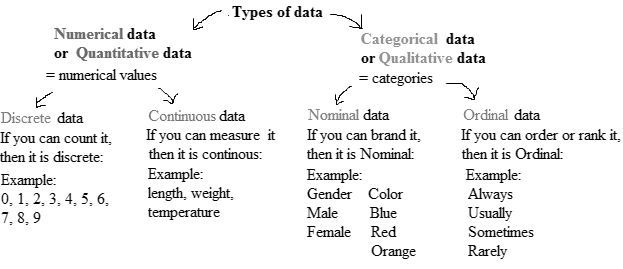
It is given that Brenda answered 2 and Jason answered 1 in response to given question, which clearly implies Brenda owns more cars than Jason. Brenda’s answer reflects twice as much as cars than Jason.
f.
To identify:Whether the responses to question (iii) nominal or ordinal.
Answer to Problem 49E
The responses to question (iii): nominal.
Explanation of Solution
Given information: A survey is administered by a marketing firm. Two of the people surveyed are Brenda and Jason. Three of the questions are as follows:
i. Do you favor the construction of a new shopping mall?
(1) Strongly oppose (2) Somewhat oppose (3) Neutral (4) Somewhat favor (5) Strongly favor
ii. How many cars do you own?
iii. What is your marital status?
(1) Married (2) Single (3) Divorced (4) Domestically partnered (5) Other
Concept Involved:
There are various methods of collecting information by sampling. Once the information has been collected, the collection is called a data set. Variables can be divided into two types: qualitative and quantitative. Qualitative variables are also called categorical variable, classify individuals into categories. Quantitative variables are numerical and tell how much of something there is.
Qualitative variables come in two types: ordinal variables and nominal variables.
Ordinal variables are qualitative variables whose categories have a natural ordering.
Nominal variables are qualitative variables whose categories have no natural ordering.
Quantitative variables can be either discrete or continuous.
Discrete variables are those whose possible values can be listed. Often, discrete variables result from counting something, so the possible values of the variable are 0, 1, 2 and so forth.
Continuous variables can, in principle, take on any value within some interval.
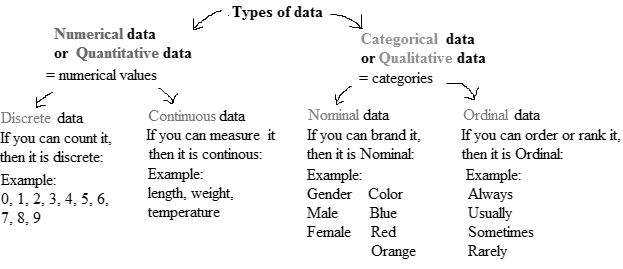
The values are classified into categories in a nominal variable, but no natural ordering is there in categories, whereas, the values are also classified into categories in an ordinary variable but a natural ordering is there in categories.
Thus, the responses to given question classifies one’s marital status into five categories.
Therefore, responses to given question are nominal.
g.
To identify:Whether Brenda’s answers reflect more of something and reflect twice as much as something.
Answer to Problem 49E
Brenda’s response of 4 and Jason’s response of 2 do not reflect more of something. Brenda’s answer does not reflect twice as much as Jason’s.
Explanation of Solution
Given information: A survey is administered by a marketing firm. Two of the people surveyed are Brenda and Jason. Three of the questions are as follows:
i. Do you favor the construction of a new shopping mall?
(1) Strongly oppose (2) Somewhat oppose (3) Neutral (4) Somewhat favor (5) Strongly favor
ii. How many cars do you own?
iii. What is your marital status?
- Married (2) Single (3) Divorced (4) Domestically partnered (5) Other On question (iii), Brenda answers (4) and Jason answers (2).
Concept Involved:
There are various methods of collecting information by sampling. Once the information has been collected, the collection is called a data set. Variables can be divided into two types: qualitative and quantitative. Qualitative variables are also called categorical variable, classify individuals into categories. Quantitative variables are numerical and tell how much of something there is.
Qualitative variables come in two types: ordinal variables and nominal variables.
Ordinal variables are qualitative variables whose categories have a natural ordering.
Nominal variables are qualitative variables whose categories have no natural ordering.
Quantitative variables can be either discrete or continuous.
Discrete variables are those whose possible values can be listed. Often, discrete variables result from counting something, so the possible values of the variable are 0, 1, 2 and so forth.
Continuous variables can, in principle, take on any value within some interval.
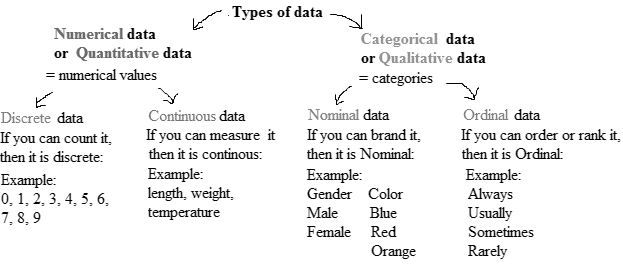
The values are classified into categories in a nominal variable, but no natural ordering is there in categories, whereas, the values are also classified into categories in an ordinary variable but a natural ordering is there in categories.
Thus, the responses to given question classifies one’s marital status into five categories.
Response to Marital status are nominal in nature, thus primarily the variable marital status is categorical. Hence, Brenda’s response of 4 and Jason’s response of 2 do not reflect more of something.
Therefore, Brenda’s answer does not reflect twice as much as Jason’s
Want to see more full solutions like this?
Chapter 1 Solutions
ELEMENTARY STATISTICS-ALEKS ACCESS CODE
- At the same restaurant as in Question 19 with the same normal distribution, what's the chance of it taking no more than 15 minutes to get service?arrow_forwardClint, obviously not in college, sleeps an average of 8 hours per night with a standard deviation of 15 minutes. What's the chance of him sleeping between 7.5 and 8.5 hours on any given night? 0-(7-0) 200 91109s and doiw $20 (8-0) mol 8520 slang $199 galbrog seam side pide & D (newid se od poyesvig as PELEO PER AFTE editiw noudab temand van Czarrow_forwardTimes to complete a statistics exam have a normal distribution with a mean of 40 minutes and standard deviation of 6 minutes. Deshawn's time comes in at the 90th percentile. What percentage of the students are still working on their exams when Deshawn leaves?arrow_forward
- Suppose that the weights of cereal boxes have a normal distribution with a mean of 20 ounces and standard deviation of half an ounce. A box that has a standard score of o weighs how much? syed by ilog ni 21arrow_forwardBob scores 80 on both his math exam (which has a mean of 70 and standard deviation of 10) and his English exam (which has a mean of 85 and standard deviation of 5). Find and interpret Bob's Z-scores on both exams to let him know which exam (if either) he did bet- ter on. Don't, however, let his parents know; let them think he's just as good at both subjects. algas 70) sering digarrow_forwardSue's math class exam has a mean of 70 with a standard deviation of 5. Her standard score is-2. What's her original exam score?arrow_forward
- Clint sleeps an average of 8 hours per night with a standard deviation of 15 minutes. What's the chance he will sleep less than 7.5 hours tonight? nut bow visarrow_forwardSuppose that your score on an exam is directly at the mean. What's your standard score?arrow_forwardOne state's annual rainfall has a normal dis- tribution with a mean of 100 inches and standard deviation of 25 inches. Suppose that corn grows best when the annual rainfall is between 100 and 150 inches. What's the chance of achieving this amount of rainfall? wved now of sociarrow_forward
- 13 Suppose that your exam score has a standard score of 0.90. Does this mean that 90 percent of the other exam scores are lower than yours?arrow_forwardBob's commuting times to work have a nor- mal distribution with a mean of 45 minutes and standard deviation of 10 minutes. How often does Bob get to work in 30 to 45 minutes?arrow_forwardBob's commuting times to work have a nor- mal distribution with a mean of 45 minutes and standard deviation of 10 minutes. a. What percentage of the time does Bob get to work in 30 minutes or less? b. Bob's workday starts at 9 a.m. If he leaves at 8 a.m., how often is he late?arrow_forward
 Big Ideas Math A Bridge To Success Algebra 1: Stu...AlgebraISBN:9781680331141Author:HOUGHTON MIFFLIN HARCOURTPublisher:Houghton Mifflin Harcourt
Big Ideas Math A Bridge To Success Algebra 1: Stu...AlgebraISBN:9781680331141Author:HOUGHTON MIFFLIN HARCOURTPublisher:Houghton Mifflin Harcourt Holt Mcdougal Larson Pre-algebra: Student Edition...AlgebraISBN:9780547587776Author:HOLT MCDOUGALPublisher:HOLT MCDOUGAL
Holt Mcdougal Larson Pre-algebra: Student Edition...AlgebraISBN:9780547587776Author:HOLT MCDOUGALPublisher:HOLT MCDOUGAL Glencoe Algebra 1, Student Edition, 9780079039897...AlgebraISBN:9780079039897Author:CarterPublisher:McGraw Hill
Glencoe Algebra 1, Student Edition, 9780079039897...AlgebraISBN:9780079039897Author:CarterPublisher:McGraw Hill Functions and Change: A Modeling Approach to Coll...AlgebraISBN:9781337111348Author:Bruce Crauder, Benny Evans, Alan NoellPublisher:Cengage Learning
Functions and Change: A Modeling Approach to Coll...AlgebraISBN:9781337111348Author:Bruce Crauder, Benny Evans, Alan NoellPublisher:Cengage Learning Algebra and Trigonometry (MindTap Course List)AlgebraISBN:9781305071742Author:James Stewart, Lothar Redlin, Saleem WatsonPublisher:Cengage Learning
Algebra and Trigonometry (MindTap Course List)AlgebraISBN:9781305071742Author:James Stewart, Lothar Redlin, Saleem WatsonPublisher:Cengage Learning Algebra: Structure And Method, Book 1AlgebraISBN:9780395977224Author:Richard G. Brown, Mary P. Dolciani, Robert H. Sorgenfrey, William L. ColePublisher:McDougal Littell
Algebra: Structure And Method, Book 1AlgebraISBN:9780395977224Author:Richard G. Brown, Mary P. Dolciani, Robert H. Sorgenfrey, William L. ColePublisher:McDougal Littell





